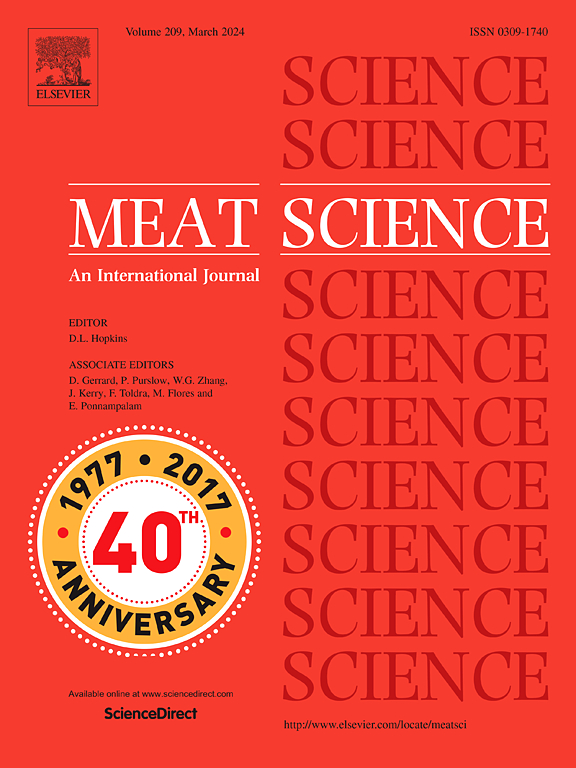食用多年生小麦的羔羊肉中脂肪酸和氧化生物标志物的浓度与不同豆科植物(三叶草、塞拉菜或苜蓿)或矿物质补充剂的二元混合物
IF 6.1
1区 农林科学
Q1 Agricultural and Biological Sciences
引用次数: 0
摘要
研究人员比较了72只羔羊肉(n = 72)的脂肪酸分布和氧化稳定性生物标志物,这些羔羊肉分别饲喂多年生小麦、地下三叶草、法国塞拉地拉、苜蓿或矿物质补充剂。试验采用分块设计,将3只杂交母羊分配到4种饲料类型中,在6个区重复。96 d后屠宰羔羊,分析腰最长肌样本。放牧多年生小麦+塞拉苔的羔羊TBARS值低于放牧多年生小麦+地下三叶草的羔羊。饲粮类型对肉中总酚类化合物、蛋白质羰基含量、α-生育酚含量、铁还原抗氧化潜力或Trolox等效抗氧化能力均无影响(P >;0.05)。多年生小麦加地下三叶草饲羔羊的C16:1n-7 t水平高于多年生小麦加塞拉苔和添加矿物质饲羔羊(P = 0.014)。其他饲料类型对肉质脂肪酸分布没有影响(P >;0.05)。C20:5n-3 + C22:6n-3浓度为>;每135克羊肉中含有50毫克的omega-3脂肪酸,这意味着所有的羊肉都可以被称为“omega-3脂肪酸的来源”或“omega-3脂肪酸含量高”——这取决于法律权威。饲料类型对动脉粥样硬化、过氧化物性和血栓性脂肪酸指标没有影响(P >;0.05)。这些发现证实,在多年生谷物和豆类的不同二元混合物中,羔羊肉的脂肪酸和氧化稳定性可以实现“健康”。本文章由计算机程序翻译,如有差异,请以英文原文为准。
Fatty acid and oxidation biomarker concentrations in meat from lambs grazing perennial wheat in binary mixtures with different legumes (clover, serradella, or lucerne) or with a mineral supplement
Fatty acid profile and oxidative stability biomarkers were compared for meat from lambs (n = 72) grazing perennial wheat plus subterranean clover, French serradella, lucerne, or with a mineral supplement. It followed a split-plot design, wherein 3 crossbred ewe lambs were allocated to each of 4 forage types, replicated across 6 blocks. Lambs were slaughtered after 96-d and samples from the longissimus lumborum muscle were analysed. Lambs grazing perennial wheat plus serradella had lower TBARS values than found for those grazing perennial wheat plus subterranean clover. No forage type effect was observed on total phenolic compounds, protein carbonyl content, α-tocopherol content, ferric reducing antioxidant potential, or Trolox equivalent antioxidant capacity of the meat (P > 0.05). C16:1n-7 t levels were higher for lambs fed perennial wheat plus subterranean clover than was found for those fed perennial wheat plus serradella or plus a mineral supplement (P = 0.014). There was no other forage type effect on the fatty acid profile of the meat (P > 0.05). C20:5n-3 plus C22:6n-3 concentrations were > 50 mg per 135 g serve, meaning that all the lamb meat could be claimed to be ‘a source of omega-3s’ or ‘high in omega-3 fatty acids’ – depending on the statutory authority. There were no forage type effects on the atherogenic, peroxidability, and thrombogenic fatty acid indices (P > 0.05). These findings confirm that a ‘healthy’ profile of fatty acids and oxidative stability can be achieved in the meat of lambs grazing different binary mixes of perennial cereal and legume.
求助全文
通过发布文献求助,成功后即可免费获取论文全文。
去求助
来源期刊

Meat Science
工程技术-食品科技
CiteScore
12.60
自引率
9.90%
发文量
282
审稿时长
60 days
期刊介绍:
The aim of Meat Science is to serve as a suitable platform for the dissemination of interdisciplinary and international knowledge on all factors influencing the properties of meat. While the journal primarily focuses on the flesh of mammals, contributions related to poultry will be considered if they enhance the overall understanding of the relationship between muscle nature and meat quality post mortem. Additionally, papers on large birds (e.g., emus, ostriches) as well as wild-captured mammals and crocodiles will be welcomed.
 求助内容:
求助内容: 应助结果提醒方式:
应助结果提醒方式:


